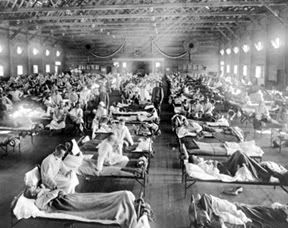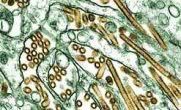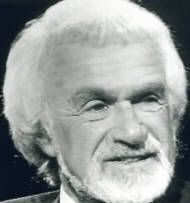INFLUENZA: A Real Threat
H5N1: Humanity's greatest threat


As I post this in October 2007 the bird flu virus is making a couple of significant mutations that will allow it to transfer more easily from birds to humans. While this is a scary development, it also is a hopeful one. Meaning, we are one step closer in figuring out how the "jump" from birds to humans is made. Maybe knowing how it happens will allow our scientists to find a way for preventing it.
The last killer pandemic was in 1918. I've read numbers ranging between 20 MILLION and 50 MILLION deaths in that year. My paternal and maternal grandparents were all approximately five years old during this tragedy. I'm thankful they lived. If any one of the four of them had died I would either not exist today or be a different person (which is the same as saying I (this I) would not exist. That scenario is the same for anyone reading this, regardless of how many lines of progeny you go back, whether it's one, two or three.
Pandemic test undertaken by financial services paints dire scenarioPatrick Thibodeau October 24, 2007 (Computerworld) If a pandemic strikes the U.S., it will kill about 1.7 million people, hospitalize 9 million, exhaust antiviral medications and reduce basic food supplies, according to a planning scenario developed by financial service firms preparing for such a catastrophe. October 24, 2007 (Computerworld) If a pandemic strikes the U.S., it will kill about 1.7 million people, hospitalize 9 million, exhaust antiviral medications and reduce basic food supplies, according to a planning scenario developed by financial service firms preparing for such a catastrophe.This particular disaster occurred only on paper. But those grim numbers are some of the pandemic planning assumptions used by nearly 3,000 banks, insurance companies and security firms in a just-concluded, three-week, paper-based exercise that may have been the largest pandemic test of its kind. In each week of this drill, participants -- some 10,000 people were involved -- received an updated scenario and were asked to assess their capability to deliver services as the pandemic deepened and then abated. "We wanted to look at the impact a pandemic can have on our sector," said George Hender, chairman of the Financial Services Coordinating Council, in a teleconference Wednesday. "One of the things that we tried to do is put some real stress on the firms." During the height of the pandemic, which was estimated to occur midway through the scenario, participants were asked to consider operating with an absentee rate of nearly 50% -- above the 35% to 40% rate federal officials believe may actually happen, said Hender. "We deliberately took the rate up much higher to see where their stress points were," he said. The financial services groups are now sharing the pandemic flu exercise information, and all the scenarios are available for download. The U.S. Department of Treasury is also a sponsor of the test, and Valerie Abend, deputy assistant secretary for critical infrastructure protection and compliance at the department, said the financial services industry has been "thinking long and hard about a pandemic." "We are one of the most prepared, I would argue, if not the most prepared of the critical infrastructures that are out there," said Abend. But the financial services firms won't really know how prepared they are until the end of the year. The thousands of pages of data collected during the test, which began in the last week of September, are still being analyzed and a final report is due at year's end. But based on some preliminary feedback from participants, the financial service firms weren't handing out too many gold stars for readiness. When asked "based on the lessons learned from the exercise, how effective are your organization's business continuity plans for a pandemic," 56% answered "moderately," the next highest group was "minimally," at 28%. Only 12% said their business continuity planning was very effective. The three-week scenario compresses the 12-week period a pandemic wave would likely last. Among the other things that may happen in an actual pandemic are school closings, as well as blackouts or brownouts in major metro areas because of degraded service as a result of absenteeism. Internet service throughput could be reduced by 50% due to congestion, and Web browsing timeouts would become common. Airlines would cut schedules, and garbage would pile up on streets. Many frustrations would arise. Working ATMs might be scarce, and call centers may not have enough staff to help. Health insurance claim volume would rise 20%. Auto claims are expected to fall 10%, since there would be less traffic on the road. But for those who are driving, gas prices would be high and fuel supplies reduced. |
HERE is some interesting reading about the 1918 PANDEMIC.
I knew it all along. Really.
Study Reveals Why Flu Thrives in WinterDave Mosher |
Also see some really interesting facts, answered questions and a video on the potential for a BIRD FLU PANDEMIC.

















<< Home